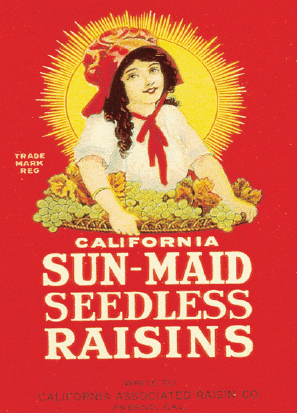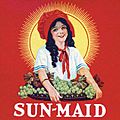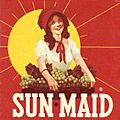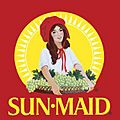Sun-Maid facts for kids
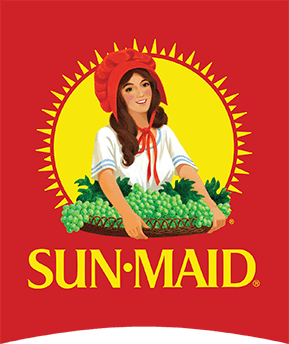
Logo in use since April 2020
|
|
| Agricultural cooperative | |
| Predecessor | California Associated Raisin Company |
| Founded | 1912 |
| Headquarters |
,
U.S.
|
|
Area served
|
California |
| Products | Raisins and dried fruit |
Sun-Maid Growers of California is a company that belongs to farmers. It is known for its raisins and dried fruits. The company's main office is in Fresno, California. Sun-Maid is one of the biggest companies in the world that processes raisins and dried fruits.
About 850 family farmers own Sun-Maid. These farmers grow raisin grapes. Their farms are usually within 100 miles (160 km) of the main processing plant. Sun-Maid also gets dried fruit from other places.
Each year, Sun-Maid makes over 200 million pounds (90 million kilograms) of raisins. These raisins are grown in the Central Valley of California. They are then packaged to be sold to people. Some are also sold to other companies to use in their products.
Many people recognize Sun-Maid by its famous red box. This box features the "Sun-Maid Girl." She wears a red sunbonnet and holds a tray of fresh grapes.
Contents
History of Sun-Maid
Early Raisin Farming
In 1873, a person named Francis T. Eisen planted special Muscat grapes. He did this near Fresno. By 1878, packaged raisins were being sent out of California. By 1903, California was making 120 million pounds of raisins every year.
Raisins became a popular crop. They grew and dried well in the sun. Because of this, more and more farmers started growing raisin grapes. But when many farmers grew them, prices for raisins would often change a lot.
Forming the Cooperative
Farmers wanted to work together to get fair prices. The first successful group of raisin growers started in 1898. In 1912, a group of farmers in the San Joaquin Valley formed a cooperative. They called it the California Associated Raisin Company.
In 1914, this company started the "Sun-Maid" brand. This was to help sell their raisins. For their first advertisement, they sent a train with 60 cars full of raisins to Chicago. Each car had a sign saying, "Raisins Grown by 6,000 California Growers." In 1918, the company opened a new building in downtown Fresno, California.
By 1922, most of California's raisin growers were part of the company. That year, the company changed its name. It became Sun-Maid Growers of California. This new name helped people connect it to the well-known Sun-Maid brand.
Growth and Challenges
In 1964, Sun-Maid opened a new large building. It was in Kingsburg, about 20 miles (32 km) south of Fresno. This building is 640,000 square feet (59,000 m2) and sits on over 100 acres (40 ha) of land. The Kingsburg plant is still the main processing center. The corporate office is in Fresno.
Sometimes, bad weather affected the grape crops. In 1972, a frost destroyed many grapes. Sun-Maid had to close its factory for the first time since 1953. In 1978, heavy rain ruined most of the crop. Sun-Maid lost about 80,000 tons of raisins. More heavy rain in 1982 caused $200 million in raisin losses for Sun-Maid.
Joining and Leaving Sun-Diamond Growers
In 1980, Sun-Maid joined with other cooperatives. These included Sunsweet Growers and Diamond Walnut Growers. Together, they formed a larger cooperative called Sun-Diamond Growers of California. This group had sales as high as $522 million in 1983.
Sun-Maid faced some financial difficulties in the mid-1980s. Some growers received too much money due to problems with records. The company worked hard to fix these issues. By 1987, the cooperative had recovered.
In 1995, Sun-Diamond bought the dried fruit business from Dole. Later, Sun-Diamond faced some legal challenges. However, Sun-Maid and other members worked with the USDA to resolve these issues. Sun-Diamond was eventually closed in 2000.
Recent Years
In 2005, Sun-Maid had its highest sales ever at that time, reaching $250 million. In 2012, Sun-Maid celebrated 100 years as a farmer-owned cooperative. At that time, 750 family farmers were part of Sun-Maid. They farmed over 50,000 acres in the Central Valley.
In 2019, the company moved its main corporate office back to Fresno. The large processing plant in Kingsburg continued its operations. In 2021, Sun-Maid bought Plum Organics, a company that makes organic baby food.
The Sun-Maid Girl
The famous "Sun-Maid Girl" was a real person. Her name was Lorraine Collett. In 1915, she was one of several young girls who represented the California Associated Raisin Company. They were at a big event called the Panama–Pacific International Exposition in San Francisco.
The Sun-Maid girls gave out raisin samples to visitors. They wore white blouses and blue sunbonnets. A photo of Lorraine Collett appeared in a newspaper in 1915. It showed what Sun-Maid was doing at the Expo.
While working at the Expo, Lorraine posed for an artist. She held a tray of grapes. The artist added a bright sunburst behind her. In May 1916, the company decided Lorraine Collett would be the face of Sun-Maid.
Her image was updated over the years. New drawings were made in 1956 and 1970. These new drawings used a company employee named Delia von Meyer (Pacheco) as a model. Lorraine Collett continued to appear at special events as the original Sun-Maid Girl until she was 90 years old.
The current Sun-Maid Girl image was created in 1970. An artist named John Lichtenwalner made it. He used the older versions to create a cleaner, more modern look. A young actress named Liz Weide was the model for this updated picture. This artwork has been used on Sun-Maid packages for over 40 years.
In 2006, the Sun-Maid Girl was brought to life. She was made into a computer-animated character for TV commercials. For the first time, she could walk and talk!
Evolution of the Brand Logo


